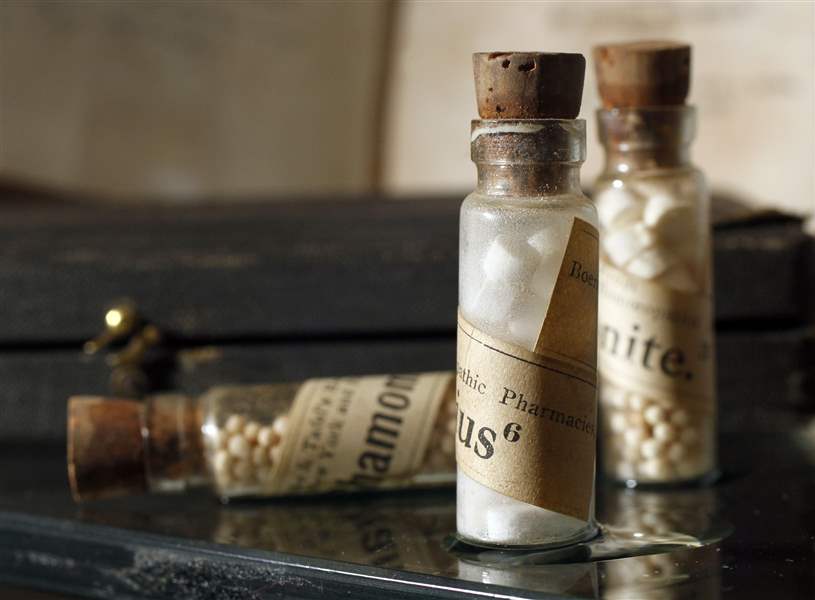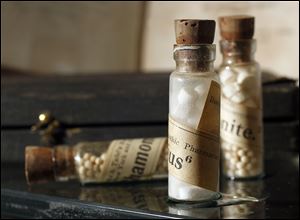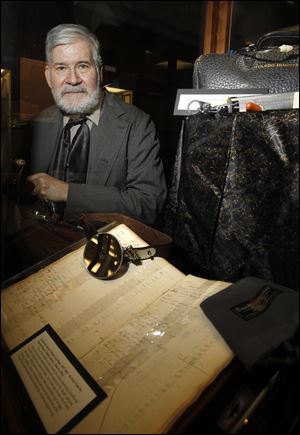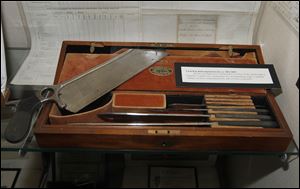
TOLEDO MAGAZINE
UT exhibit explores area’s health-care history
'Medicine on the Maumee' stretches from Black Swamp to MCO
3/11/2012
Bottles of medicine are displayed as part of "Medicine on the Maumee: A History of Health Care in Northwest Ohio" at the University of Toledo's Carlson Library.
The Blade/Andy Morrison
Buy This Image
Editor's note: In the original version of this story Canaday Center Director Barbara Floyd was misidentified as Barbara Henry.

Bottles of medicine are displayed as part of "Medicine on the Maumee: A History of Health Care in Northwest Ohio" at the University of Toledo's Carlson Library.
Welcome to "the graveyard of the Midwest," where settlers died from typhoid fever or drinking ice water and bad whiskey, and where swampy conditions caused epidemics that wiped out whole towns.
Welcome to Toledo.
Over the years, medicine has gone from black bag to big science, from house calls to hospitals to robots and computers.

John Jaeger, dressed as his great great grandfather, Frederick Jaeger, sits with a log book that belonged to the circuit-riding doctor in Woodville who practiced until the 1860s.
"Medicine on the Maumee: A History of Health Care in Northwest Ohio" on display at the University of Toledo’s Ward M. Canaday Center for Special Collections, traces the history of medicine in the Toledo area from the earliest years of settlement to current practices.
PHOTO GALLERY: Click here to view images
The exhibit looks at epidemics that devastated the population, doctors and nurses who provided care, and the industrialization of medicine.
"Medical history is a mirror of a lot of other things happening in the community — politics, the economy, poverty," said Barbara Floyd, director of the Canaday Center, located in Carlson Library on UT’s main campus. "It’s not just a focus on the history of medicine, but the history of Toledo through its history of medicine. Where we are as a community today is reflective of this."
The story begins in the middle of the Black Swamp, where cholera, a bacterial infection of the intestines, ran rampant, at one point killing 239 residents in 17 days and giving the city its deadly nickname as "graveyard of the Midwest." Doctors’ log books documenting the deaths are featured in the exhibit. Also included are letters and books published in the 1840s and ’50s by residents, doctors, and organizations describing the epidemics.
The exhibit covers the development of the first health board and area medical schools. At one time, doctors didn’t need a license to practice and there were no laws to regulate and govern medical schools.
"A few years of practical training was all they needed at the time," Ms. Floyd said.
Patient log books dating to the founding of the area’s first hospitals, and photos and uniforms of Civil War nurses also are on display.
"War advances medicine tremendously," Ms. Floyd said. "Suddenly you have all these people that need treatment, so you throw out your old remedies and start experimenting."

A Civil War amputation kit includes a bone saw.
The exhibit also features medical equipment, including a doctor’s black bag, a blood pressure machine that came in a wooden box, a portable resuscitator that resembled a gas pump, and a Civil War field amputation kit, complete with a saw, scalpel, and knives.
An atomizer, developed by Dr. Allen DeVilbiss, allowed medicine to be sprayed into the throat, much like today’s throat sprays. Before the atomizer, medicine was put on a cotton swab and stuck down the throat, Ms. Floyd said.
The story ends with the development of the Medical College of Ohio (now the University of Toledo Medical Center) and the advances of modern medical care, including an outline for treatment of HIV in the 1990s.
"Medicine on the Maumee" is free and open to the public from 8 a.m. to 5 p.m. Monday through Friday through Dec. 20. Viewing is available on Saturday by appointment.
An accompanying exhibit, "Anatomical Art: The Internal Beauty of the Human Body," is on display on the fifth floor of the library, right outside the Canaday Center, in UT’s Carlson Library on the main campus. The exhibit features human specimens that have been injected with plastic to preserve them. Actual human stomachs, diseased kidneys, brains, hands, and hearts are on display.
"Anatomical Art" is also free and open to the public. To schedule an appointment, call Barbara Floyd at 419-530-2170.
Contact RoNeisha Mullen at: rmullen@theblade.com or 419-724-6133.